Pointy End Goes on the Paper: Beginning Drawing for the SCA Scribal Arts
Scribal culture in each kingdom throughout the known world is unique. As I am Trimarian, I approach things from that perspective. But my hope is that anyone interested in Medieval Illumination can find some inspiration and tidbits in this series of articles which will be helpful.
Part 1: No Fear!
One of the biggest hurdles I see for those interested in starting to learn these arts is fear. If I had a dollar for all the times I've heard "I can't draw," "I'm not good at drawing people/plants/animals", etc, I would be able to fund my craft supply habit. We tend to have this perception of the grand masters of old, at the peak of their ability, only doing the best and most perfect artwork. That can be intimidating.
I am here to tell you that while I and my own imposter syndrome certainly understand, those perceptions are wrong. If you take a good critical look at the art of the Middle Ages.... well let's just say that not everyone can be Leonardo da Vinci. Please allow me to share some of my favorite examples with you, and hopefully by the end of this article you will agree with me that fear is a lying liar face and anyone can jump into the SCA scribal arts and do just fine.
People in Medieval Art:
With the focus on the 'great masters' of ninja turtle fame, we tend to forget that most of the people actually doing the illumination in the Middle ages were monks, nuns (yes there were female scribes!), and local artisans. This is especially true for earlier medieval periods before the Renaissance got into full swing. And while everyone did their best, artwork was just not as advanced as we expect in the modern era. There was absolutely no photo-realism, and even getting the basics down could be a challenge.
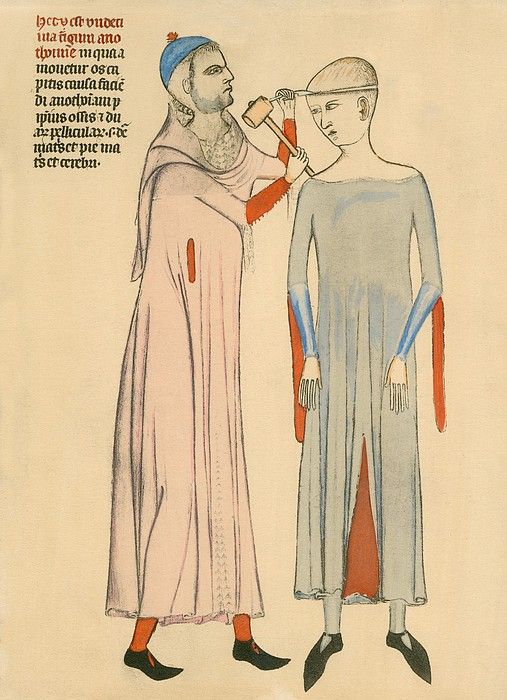 |
| Illustration from a 14th century French medical manuscript by Guy of Pavia |
Even people who should have direct first-hand knowledge of the human body got it wrong. This page is a prime example, being from an actual 14th century medical textbook. It is not anatomically correct by any stretch of the imagination. I think my favorite part might be the tiny T-rex arms, but the giant heads are a close runner up. And did you notice the disjointed shoulders and hips?
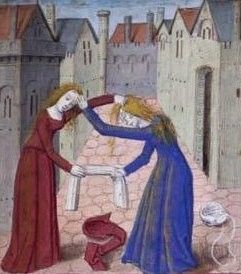 |
| Les Cent Nouvelles Nouvelles, Frankrijk, c.1475-1500, Glasgow University |
This picture from the 15th century has the opposite problem. The joints of the bodies are a little better, but what is a little hair pulling without freakishly long monkey arms to make sure that you can reach?
In any case, there are plenty of extant examples of poor anatomy choices. And if anatomy was bad in general, you better believe that the specific anatomy of women and children was even worse.
 |
| St. Nicholas refusing his mother's milk 11th cen Italian |
This is painted on the wall of an 11th century church, so I have to imagine the highest artistic standards were in place. But whoever painted this clearly didn't have a very good grasp of female anatomy, or how it works. And poor St. Nicholas has both the head of an old man and the body of a caterpillar.
 |
| Carlo Crivelli, the virgin and child, about 1480 |
Now Crivelli was one of the artistic powerhouses, but to a modern observer Mary looks like she's almost alien here. Her face is way to small for her gigantic cranium, and her fingers are likewise disproportionate.
Being unable to draw women and children was so much of a thing there is now a tumblr for that! Look up Uglyrenaissancebabies.tumblr.com for more extant examples, you won't be disappointed.
"But when I draw people they look cartoony!"
Say no more, Mon amore!
 |
| Winchester Bible - 12th century |
Cartoony enough for you? This is a classic example of early period illumination. Not only are the bodies all out of proportion, but the colors used are also a lot brighter than we've been trained to expect. So not only is cartoony just fine, it's almost a prerequisite for early period illumination.
 |
| Morgan M.969 Bible with prologues. F. 346v-2 1275-1299, France |
Bonus cartoony knight on a very confused horse! Also, note the total lack of liner perspective. I'll get into this in later posts (spoilers!)
"I only doodle"
Did someone say doodle!?
 |
Doodle found in 12th cen missal (book for mass) Paris,
Bibliothèque Sainte-Geneviève, MS 95 (Missal, 12th century) |
 |
| Doodle in a 15th century ‘schoolbook’ text used to teach morality |
Seriously, you have no excuse here. Personally, I'd love to see an SCA scroll covered in doodles and other marginalia. If you are at all interested, check out medieval book historian Erik Kwakkel. He has a great tumblr & blog where he catalogues doodles, marginalia, and other fun stuff.
Plants in Medieval Art:
Now plants tend to be treated better in medieval illumination, mostly because there was a lot more opportunity to copy them from life. But I'd be lying if I told you that all artwork of plants ended up looking like the originals... far from it. In early period, plants were highly stylized and followed particular forms. To draw a plant you would draw that form, whether or not it actually looked like the real thing. Classic example? Acanthus.
 |
Book of Hours, France, ca. 1430
MS M.64 fol. 54r |
 |
| One of these things is not like the other |
I guess the shape of the individual leaves are similar. But I would never be able to pick an acanthus out of a field just going by how they were drawn in the Middle Ages. It's not really a vine, or even that floppy.
 |
| Walters museum W.472, Italy 1505 |
 |
| The Mass of Saint Gregory (detail),
Workshop of Gerard Horenbout,
Flemish,, about 1500 |
The plants in this piece from the Walter's Museum are also very formulaic and stylized. It implies plants, but doesn't really look like any plants in particular. It's more akin to a kindergartner's interpretation of flowers. And compare it with this second piece. These are same time period but have totally different looks. Clearly botany was a more developed skill in Flanders.
 |
| Late 12th cen medical treatise, Apuleius, Folio #: fol. 023r, English |
And speaking of botany, here's another medical treatise from the 12th century. This is a botanical specifically made to identify plants and I would still be incredibly hard pressed to actually find any actual plants from the pictures alone.
Animals in Medieval Art:
Hang onto your seats, this is where things get especially fun! The fact of the matter is, a lot of animals you see in illumination are creatures the illustrator has never seen. Lion and tigers and bears, oh my! Not to mention elephants. Can you imagine trying to draw an elephant from a description recorded by a guy who heard a sailor's tale of some dude named Bob who had seen one once?
 |
| Elephants & a Rabbit in a 13th century manuscript. The British Library-Royal 12 F XIII |
Clearly elephants were just large boars with big noses, who knew? Even the rabbit here looks more like a goat with pointy ears, or maybe a lama. This illustrator must not have done too much rabbit hunting.
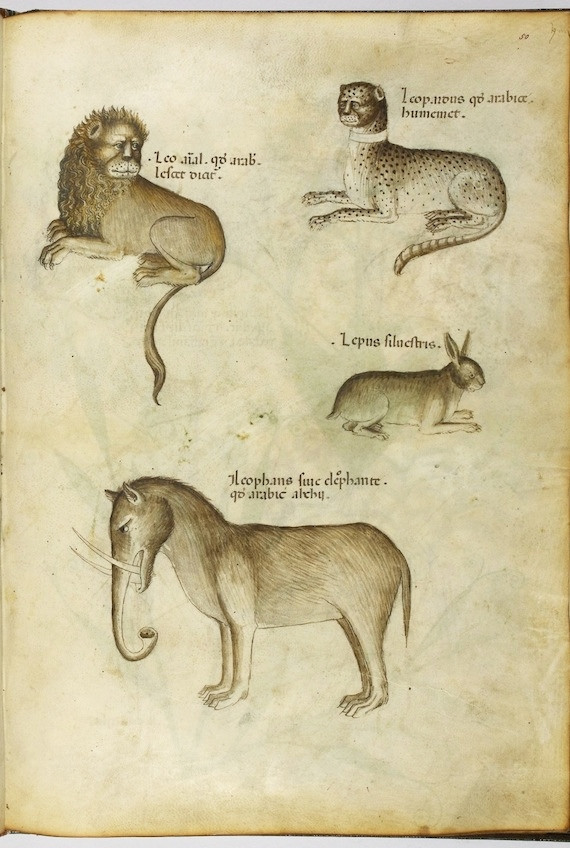 |
| Lion, Leopard, Rabbit, Elephant, Tractatus de Herbis (ca.1440) |
The rabbit here is more true to life, but the elephant still needs some work, and the big cats have eerily human faces.
And lets not get into mythical and fantasy creatures. If it was hard to draw an elephant, how about something that no one had ever actually seen? Actually... along those lines...
Craziness in Medieval Art:
"OK," you say, "I get it, a lot of medieval art was a bit wonky. But at least they were trying! I only ever draw fantasy things that have no basis in real life, there's no way that sort of stuff would be good enough for an SCA scroll..."
Oh Peanut.
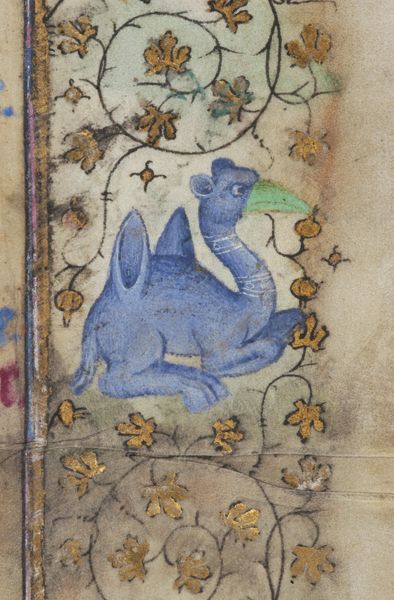 |
| Book of Hours, MS M.919 fol. 4r France 1418 |
Ears for wings!
 |
Toulouse, Bibliothèque municipale, 0096, detail of f. 048.
Dominican missal. End of the 15th century |
Multi-colored rainbow...saytr? With polka dots!
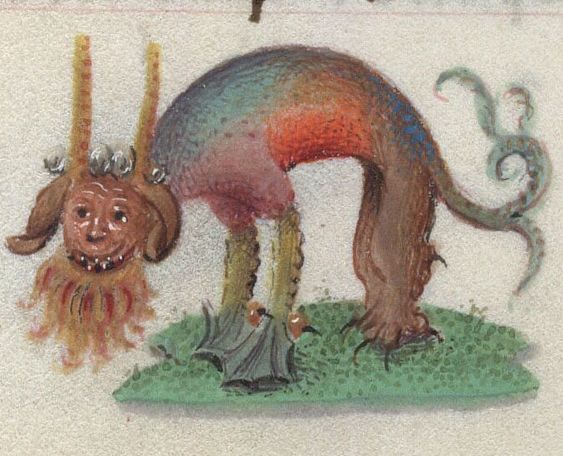 |
Yale, Beinecke Rare Book and Manuscript Library. Beinecke MS 287, detail of f.159.
Book of Hours, Use of Rome. End of the 15th century (Flanders) |
Yeah.... I got nothing.
Conclusion:
NO FEAR!
If fear is keeping you from taking that first step into trying the medieval scribal arts, if you are convinced you will never be able to draw as well as they did in period, I am here to tell you yes you can! Any scribble you can put to paper has a corollary in Medieval Art, and with practice you will only get better. If my making fun of extant examples can help you along that path, I will happily keep sharing new ones! Let's call it No Fear Friday.
For more good-natured ribbing of bad medieval art, check out my "No Fear Fridays" Series. Episode 1: Elephants!

Comments
Post a Comment